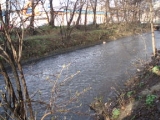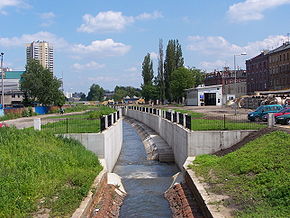
Rawa River
Encyclopedia

River
A river is a natural watercourse, usually freshwater, flowing towards an ocean, a lake, a sea, or another river. In a few cases, a river simply flows into the ground or dries up completely before reaching another body of water. Small rivers may also be called by several other names, including...
(about 19.6 kilometres in total length) in Silesia
Silesia
Silesia is a historical region of Central Europe located mostly in Poland, with smaller parts also in the Czech Republic, and Germany.Silesia is rich in mineral and natural resources, and includes several important industrial areas. Silesia's largest city and historical capital is Wrocław...
, Poland
Poland
Poland , officially the Republic of Poland , is a country in Central Europe bordered by Germany to the west; the Czech Republic and Slovakia to the south; Ukraine, Belarus and Lithuania to the east; and the Baltic Sea and Kaliningrad Oblast, a Russian exclave, to the north...
. It is the largest right tributary
Tributary
A tributary or affluent is a stream or river that flows into a main stem river or a lake. A tributary does not flow directly into a sea or ocean...
of the Brynica
Brynica
Brynica is a river in Silesia and Lesser Poland , Poland. It has a length of 55 km and is the main confluence of Czarna Przemsza. It has a source in Wymysłów, and flows through Piekary Śląskie, Wojkowice, Czeladź, Siemianowice Śląskie, Świerklaniec, Katowice, Sosnowiec and finally Mysłowice...
, itself a tributary of the Przemsza
Przemsza
Przemsza is a river in the south of Poland, a tributary of the Vistula.It originates at the confluence of the Black Przemsza and White Przemsza between the cities of Mysłowice and Jaworzno, and flows about southwards along the towns of Imielin and Chełmek to its mouth northeast of...
, which in turn is a tributary of the Vistula
Vistula
The Vistula is the longest and the most important river in Poland, at 1,047 km in length. The watershed area of the Vistula is , of which lies within Poland ....
. The entire length of the Rawa is within the Upper Silesian Metropolitan Union
Upper Silesian Metropolitan Union
The Metropolitan Association of Upper Silesia or Upper Silesia Metroplex, Silesia Metroplex / Silesia Metroplex is a union of 14 adjacent cities in the Polish province of Silesia....
. It has its source in Ruda Śląska
Ruda Slaska
Ruda Śląska is a city in Silesia in southern Poland, near Katowice. It is a district in the Upper Silesian Metropolitan Union, a metropolis with a population of 2 million. It is located in the Silesian Highlands, on the Kłodnica river ....
and crosses the cities of Świętochłowice, Chorzów
Chorzów
Chorzów is a city in Silesia in southern Poland, near Katowice. Chorzów is one of the central districts of the Upper Silesian Metropolitan Union - a metropolis with a population of 2 million...
and Katowice
Katowice
Katowice is a city in Silesia in southern Poland, on the Kłodnica and Rawa rivers . Katowice is located in the Silesian Highlands, about north of the Silesian Beskids and about southeast of the Sudetes Mountains.It is the central district of the Upper Silesian Metropolis, with a population of 2...
. Finally in Sosnowiec
Sosnowiec
Sosnowiec is a city in Zagłębie Dąbrowskie in southern Poland, near Katowice. It is one of the central districts of the Upper Silesian Metropolitan Union - a metropolis with a combined population of over two million people located in the Silesian Highlands, on the Brynica river .It is situated in...
it joins the Brynica
Brynica
Brynica is a river in Silesia and Lesser Poland , Poland. It has a length of 55 km and is the main confluence of Czarna Przemsza. It has a source in Wymysłów, and flows through Piekary Śląskie, Wojkowice, Czeladź, Siemianowice Śląskie, Świerklaniec, Katowice, Sosnowiec and finally Mysłowice...
River only several hundred metres before the latter joins with Czarna Przemsza.
The Rawa has lost most of its natural river character, and is now mostly a sewage
Sewage
Sewage is water-carried waste, in solution or suspension, that is intended to be removed from a community. Also known as wastewater, it is more than 99% water and is characterized by volume or rate of flow, physical condition, chemical constituents and the bacteriological organisms that it contains...
channel flowing underground. Works have begun in order to restore it back to an ecologically sound water flow.
Characteristics
The river has a source in the Marcin pond in Ruda ŚląskaRuda Slaska
Ruda Śląska is a city in Silesia in southern Poland, near Katowice. It is a district in the Upper Silesian Metropolitan Union, a metropolis with a population of 2 million. It is located in the Silesian Highlands, on the Kłodnica river ....
. It flows through Świętochłowice, Chorzów
Chorzów
Chorzów is a city in Silesia in southern Poland, near Katowice. Chorzów is one of the central districts of the Upper Silesian Metropolitan Union - a metropolis with a population of 2 million...
, Katowice
Katowice
Katowice is a city in Silesia in southern Poland, on the Kłodnica and Rawa rivers . Katowice is located in the Silesian Highlands, about north of the Silesian Beskids and about southeast of the Sudetes Mountains.It is the central district of the Upper Silesian Metropolis, with a population of 2...
, Mysłowice and finally Sosnowiec
Sosnowiec
Sosnowiec is a city in Zagłębie Dąbrowskie in southern Poland, near Katowice. It is one of the central districts of the Upper Silesian Metropolitan Union - a metropolis with a combined population of over two million people located in the Silesian Highlands, on the Brynica river .It is situated in...
where it joins Brynica
Brynica
Brynica is a river in Silesia and Lesser Poland , Poland. It has a length of 55 km and is the main confluence of Czarna Przemsza. It has a source in Wymysłów, and flows through Piekary Śląskie, Wojkowice, Czeladź, Siemianowice Śląskie, Świerklaniec, Katowice, Sosnowiec and finally Mysłowice...
just before the latter joins with Czarna Przemsza.
During much of its route it flows underground, beneath the city's infrastructure. It is filled by rain, as well as sewage. It has several small confluences, such as Potok Leśny (near University of Economics in Katowice
University of Economics in Katowice
The University of Economics in Katowice , is the only state university specializing in Economics and Business studies in the region. It has an annual enrollment about 13,500 students, and has 480 teachers. It was founded in 1937 as the College of Social and Economic Sciences, closing because of...
).
Pollution
The river is notorious for being heavily polluted. Reported to be crystal clear in 1875, the industrialization of SilesiaSilesia
Silesia is a historical region of Central Europe located mostly in Poland, with smaller parts also in the Czech Republic, and Germany.Silesia is rich in mineral and natural resources, and includes several important industrial areas. Silesia's largest city and historical capital is Wrocław...
caused the river to become so polluted that all the fish died out by 1893. The continued growth of industry and cities throughout the 20th century, combined with little effort towards preserving the environment, continued to degrade the quality of the water in the river. In 1992, the river, leaving Katowice, was claimed to contain only 14% water , and a popular joke among the local citizens was to warn each other 'not to throw a lit match into the river'. Currently the upper part of the river is officially classified as sewage and the plan is to direct the entire river flow through a treatment plant. In the 1990s plans to improve water quality and restore the ecology of the river were begun. So far new sewage treatment plants have been completed, and the plan is supposed to significantly improve the river's quality by 2010.
Regulation of flow
The primary reason for the regulation of the Rava's flow was the need to prevent flooding as miningMining
Mining is the extraction of valuable minerals or other geological materials from the earth, from an ore body, vein or seam. The term also includes the removal of soil. Materials recovered by mining include base metals, precious metals, iron, uranium, coal, diamonds, limestone, oil shale, rock...
continued to lower the level of local lands. The first plans for controlling the flow date to 1863. Plans to regulate the entire length of the Rawa were ready in 1903. The start of the First World War interrupted Prussian government implementation. After the war, the German plans were continued by the government of the Second Polish Republic
Second Polish Republic
The Second Polish Republic, Second Commonwealth of Poland or interwar Poland refers to Poland between the two world wars; a period in Polish history in which Poland was restored as an independent state. Officially known as the Republic of Poland or the Commonwealth of Poland , the Polish state was...
in the late 1920s, with the construction of a sewage treatment plant (no longer existing). The work was completed in 1938, but the correct flow conditions did not last because of the continued lowering of the land. The second regulation of the river was conducted between 1975 and 1993.
Name
Sources first mention the river in 1737, as Róździanka - from an old village of Roździeń, now part of Katowice's district of SzopieniceSzopienice
Szopienice-Burowiec is a district of Katowice....
. The etymology of the name "Rawa" (Rava) is ancient. The name is related to Protoindoeuropean: *er[e](w)-, *rē(w)- (meaning quiet); Germanic: *rḗw-ō, *rṓw-ō, *rōw-a- (Old English: rōw, -e `quiet, rest'; Middle Dutch: rouwe, rowe; Middle Low German: rouwe, rōwe; rāwe; Old High German: ruowa (AD 800), rāwa (9 century); Middle High German: ruowe, ruo, rāwe, rouwe, German Ruhe).

